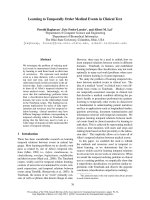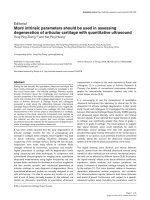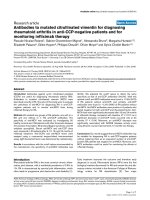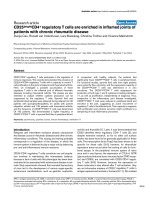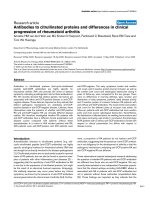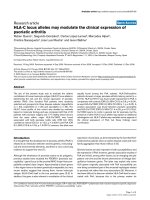Báo cáo y học: "Antibodies to citrullinated proteins and differences in clinical progression of rheumatoid arthritis" ppsx
Bạn đang xem bản rút gọn của tài liệu. Xem và tải ngay bản đầy đủ của tài liệu tại đây (356.16 KB, 10 trang )
Open Access
Available online />R949
Vol 7 No 5
Research article
Antibodies to citrullinated proteins and differences in clinical
progression of rheumatoid arthritis
Annette HM van der Helm-van Mil, Kirsten N Verpoort, Ferdinand C Breedveld, René EM Toes and
Tom WJ Huizinga
Department of Rheumatology, Leiden University Medical Center, Leiden, The Netherlands
Corresponding author: Annette HM van der Helm-van Mil,
Received: 23 Mar 2005 Revisions requested: 18 Apr 2005 Revisions received: 22 Apr 2005 Accepted: 11 May 2005 Published: 14 Jun 2005
Arthritis Research & Therapy 2005, 7:R949-R958 (DOI 10.1186/ar1767)
This article is online at: />© 2005 van der Helm-van Mil et al, licensee BioMed Central Ltd.
This is an Open Access article distributed under the terms of the Creative Commons Attribution License ( />2.0), which permits unrestricted use, distribution, and reproduction in any medium, provided the original work is cited.
Abstract
Antibodies to citrullinated proteins (anti-cyclic-citrullinated
peptide [anti-CCP] antibodies) are highly specific for
rheumatoid arthritis (RA) and precede the onset of disease
symptoms, indicating a pathogenetic role for these antibodies in
RA. We recently showed that distinct genetic risk factors are
associated with either anti-CCP-positive disease or anti-CCP-
negative disease. These data are important as they indicate that
distinct pathogenic mechanisms are underlying anti-CCP-
positive disease or anti-CCP-negative disease. Likewise, these
observations raise the question of whether anti-CCP-positive
RA and anti-CCP-negative RA are clinically different disease
entities. We therefore investigated whether RA patients with
anti-CCP antibodies have a different clinical presentation and
disease course compared with patients without these
autoantibodies. In a cohort of 454 incident patients with RA,
228 patients were anti-CCP-positive and 226 patients were
anti-CCP-negative. The early symptoms, tender and swollen
joint count, and C-reactive protein level at inclusion, as well as
the swollen joint count and radiological destruction during 4
years of follow-up, were compared for the two groups. There
were no differences in morning stiffness, type, location and
distribution of early symptoms, patients' rated disease activity
and C-reactive protein at inclusion between RA patients with
and without anti-CCP antibodies. The mean tender and swollen
joint count for the different joints at inclusion was similar. At
follow-up, patients with anti-CCP antibodies had more swollen
joints and more severe radiological destruction. Nevertheless,
the distribution of affected joints, for swelling, bone erosions and
joint space narrowing, was similar. In conclusion, the phenotype
of RA patients with or without anti-CCP antibodies is similar with
respect to clinical presentation but differs with respect to
disease course.
Introduction
Autoantibodies directed to citrullinated proteins (e.g. anti-
cyclic-citrullinated peptide [anti-CCP] antibodies) are highly
specific serological markers for rheumatoid arthritis (RA) that
are thought to be directly involved in the disease pathogenesis
[1]. Citrullinated proteins are not exclusively located in synovial
tissue of RA patients, but can also be found in synovium sam-
ples of patients with other inflammatory joint diseases [2] –
suggesting that the specificity of anti-CCP antibodies for RA
is not due to the expression of citrullinated proteins, but might
be the result of an abnormal humoral response. Intriguingly,
this antibody response may occur years before any clinical
symptoms, as shown by the presence of anti-CCP antibodies
several years before the clinical onset of arthritis [3,4]. Further-
more, a proportion of RA patients do not harbour anti-CCP
antibodies, suggesting that the presence of anti-CCP antibod-
ies is not obligatory for the development of arthritis or that the
pathogenic mechanisms underlying anti-CCP-positive RA and
anti-CCP-negative RA are different.
These observations inspired subsequent research addressing
the question of whether RA patients with anti-CCP antibodies
are different from those who are anti-CCP-negative. We very
recently demonstrated in two independent Caucasian popula-
tions that the shared epitope encoding HLA-DBR1 alleles is
associated with RA in patients with anti-CCP antibodies but
not in patients without these antibodies (unpublished data,
[5]). These findings are important as they indicate that the
anti-CCP = anti-cyclic-citrullinated peptide antibodies; CI = confidence interval; MCP = metacarpophalangeal; PIP = proximal interphaleangeal; RA
= rheumatoid arthritis; SD = standard deviation.
Arthritis Research & Therapy Vol 7 No 5 van der Helm-van Mil et al.
R950
shared epitope alleles are not associated with RA as such, but
rather with a particular phenotype of the disease.
Given the findings suggesting a pathophysiological role for
anti-CCP antibodies in RA and the reported immunogenetic
differences between anti-CCP-positive and anti-CCP-nega-
tive patients, it is conceivable that anti-CCP-positive RA and
anti-CCP-negative RA are different disease entities and thus
have different phenotypical properties. Anti-CCP antibodies
have been suggested to be associated with more severe radi-
ological outcome [5,6]. To our knowledge, however, a detailed
description of the distribution and degree of early symptoms
and signs in both patient groups has not been published. Nev-
ertheless, such an analysis is relevant as it might provide novel
insight into the putative pathogenic role of anti-CCP antibod-
ies in the aetiology of the disease.
In this study, therefore, we set out to determine whether anti-
CCP-positive RA patients and anti-CCP-negative RA patients
differ in different aspects of their phenotype: the early symp-
toms of disease, the findings of physical examination at initial
presentation, or the acute phase reactant C-reactive protein at
initial presentation. Moreover, we expanded the data on the
influence of anti-CCP antibodies on the disease course during
4-year follow-up for the distribution and extent of both inflam-
mation (swollen joints) and radiological joint destruction. We
show that the phenotype of RA patients with or without anti-
CCP antibodies is similar with respect to clinical presentation
but differs with respect to disease course.
Patients and methods
Patients
An Early Arthritis Clinic was started in 1993 at the Department
of Rheumatology of the Leiden University Medical Center, the
only referral centre for rheumatology in a health care region of
about 400,000 inhabitants in the western part of The Nether-
lands [7]. General practitioners were encouraged to refer
patients directly when arthritis was suspected. Referred
patients could be seen within 2 weeks and were included in
the programme when the physician's examination of the
patients revealed arthritis and the symptoms had lasted less
than 2 years.
At the first visit the rheumatologist answered a questionnaire
inquiring about the initial symptoms as reported by the patient
(type of initial joint symptoms, localization and distribution of
initial joint symptoms, presence of morning stiffness). Patients
rated their global assessment of disease activity on a visual
analogue scale (0–100). The Health Assessment Question-
naire, a self-assessed questionnaire asking about the ability of
the patient to perform several daily activities over the past
week, was used to obtain an index of disability. A tender joint
count and a swollen joint count [8,9] were performed on enter-
ing the study and yearly thereafter. For the tender joint count,
each joint was scored on a 0–3 scale with 3 being maximal
tenderness (0 = no tenderness, 1 = pain on pressure, 2 = pain
and winced, and 3 = winced and withdrew). For the swollen
joint count, the individual joints were scored on a 0–1 scale (0
= no swelling, and 1 = swelling).
At inclusion, blood samples were taken from every patient for
routine diagnostic laboratory screening including C-reactive
protein and were stored to determine antibodies to CCP2 at a
later time point. The anti-CCP2 antibody ELISA (Immunoscan
RA Mark 2; Euro-diagnostica, Arnhem, The Netherlands) was
performed according to the manufacturer's instructions with a
cut-off value of 25 units.
More than 1600 early arthritis patients are presently included
in the Early Arthritis Clinic cohort and have a follow-up of at
least 1 year. A total of 454 patients fulfilled the diagnosis of RA
according to criteria of the 1987 American College of Rheu-
matology 1 year after inclusion in the study. The treatment of
the patients in our longitudinal cohort study is characterized by
a secular trend. The 122 RA patients (61 anti-CCP-negative
and 61 anti-CCP-positive) included between 1993 and 1995
were treated initially with analgesics and subsequently with
chloroquine or salazopyrine if they had persistent active dis-
ease (delayed treatment). The 135 (70 anti-CCP-negative and
65 anti-CCP-positive) RA patients included between 1996
and 1998 were promptly treated with either chloroquine or
salazopyrine (early treatment) (for further description, see
[10]). The 197 RA patients (97 anti-CCP-negative and 100
anti-CCP-positive) included after 1998 were promptly treated
with either methotrexate or salazopyrine (early treatment).
The rheumatologists that treated the patients were not aware
of the anti-CCP status of their patients because anti-CCP anti-
bodies were not routinely determined at inclusion but were
assessed for research purposes years after inclusion using
stored serum samples. Patients gave their informed consent
and the local Ethical Committee approved the protocol.
Radiographic progression
Radiographs of the hands and feet were made at baseline, at
1 year and yearly thereafter. For 138 patients a complete radi-
ological follow-up was available for 4 years. Inherent to an
inception cohort, not all included patients had already com-
pleted 4 years of follow-up. Radiographs were scored using
the Sharp–van der Heijde method [11]. The rheumatologist
that scored the radiographs was blinded to the clinical data
and was unaware of the study question. The distribution of
radiological destruction of the small joints was studied by
comparing the erosion score and joint space narrowing score
of the metacarpophalangeal (MCP) and proximal interphalan-
geal (PIP) joints of the hands.
Statistical analysis
Differences in means between groups were analysed with the
Mann-Whitney test or the t test when appropriate. Proportions
Available online />R951
were compared using the chi-square test. In the analysis of the
tender joint count and the swollen joint count, the scores for
the left and right joints were summed for each joint location.
Furthermore, the scores for the individual MCP joints were
summed, as well as the scores for the metatarsophalangeal
joints and the interphalangeal joints of the hands and feet. For
the 138 RA patients with complete 4-year radiological follow-
up, the swollen joint count, the erosion score and the joint
space narrowing score were determined for the individual
MCP and PIP joints of the hands at inclusion and at 2 and 4
years follow-up, and are expressed as the mean with the 95%
confidence interval (CI).
The distribution and degree of radiological destruction and
swelling of these joints was studied by comparing the variance
of these scores for the individual joints. The 95% CI was used
as a measure of variance; as the number of observations in this
study is constant (138 patients at all time points during 4 years
of follow-up), the extent of the CI reflects the degree of vari-
ance. Correlations between joint swelling and erosion score or
joint space narrowing score were determined for each MCP
and PIP joint of the hands using the Spearman correlation test.
The Statistical Package for Social Sciences, version 12.0.1
(SPSS Institute, Chicago, IL, USA) was used to analyse the
data. In all tests, P < 0.05 was considered significant.
Table 1
Characteristics of the early symptoms in rheumatoid arthritis patients with and without anti-cyclic-citrullinated peptide (anti-CCP)
antibodies
Anti-CCP-negative (n = 228) Anti-CCP-positive (n = 226)
Female [n (%)] 147 (64%) 150 (66%)
Age at inclusion (mean ± standard deviation) 57 ± 17 55 ± 16
Morning stiffness
No [n (%)] 30 (13%) 30 (13%)
Yes (min) (mean ± standard deviation) 118 ± 138 123 ± 128
Type of initial joint symptoms [n (%)]
a
Pain 208 (91%) 205 (91%)
Swelling 146 (64%) 135 (60%)
Stiffness 106 (46%) 85 (38%)
Function loss 64 (28%) 57 (25%)
Redness or increased surface temperature of joints 19 (8%) 26 (12%)
Localization of initial joint symptoms [n (%)]
Small joints of hands and/or feet 105 (46%) 112 (50%)
Large joints 54 (24%) 50 (22%)
Both small and large joints 63 (28%) 59 (26%)
Unknown 6 (2%) 5 (2%)
Localization of initial joint symptoms [n (%)]
Upper limbs 114 (50%) 86 (38%)*
Lower limbs 72 (32%) 77 (34%)
Both upper and lower limbs 25 (11%) 45 (20%)*
Unknown 18 (8%) 18 (8%)
Localization of initial joint symptoms [n (%)]
Symmetric 145 (64%) 130 (58%)
Asymmetric 71 (31%) 83 (37%)
Unknown 10 (4%) 13 (6%)
VAS patients' rated global disease activity (0–100) 51.3 ± 39.9 46.7 ± 28.2
HAQ score (mean ± standard deviation) 1.0 ± 0.7 1.0 ± 0.7
VAS, visual analogue scale. HAQ, Health Assessment Questionnaire.
a
Patients can have both swelling and pain at the start of the symptoms and therefore the total can add to more than 100%.
* P < 0.05, anti-CCP-positive versus anti-CCP-negative.
Arthritis Research & Therapy Vol 7 No 5 van der Helm-van Mil et al.
R952
Results
Early symptoms of disease
In total 454 patients fulfilled the American College of Rheuma-
tology criteria for RA; 228 of these patients had anti-CCP anti-
bodies and 226 patients had no anti-CCP antibodies at
inclusion. Patient characteristics and the type, localization and
distribution of initial disease symptoms are presented in Table
1. In both groups, 13% of patients reported no morning stiff-
ness. In the patients that did experience morning stiffness, the
mean duration in the anti-CCP-negative patients and anti-
CCP-positive patients was similar at 118 min and 123 min,
respectively. In both groups symptoms started with pain and
swelling, predominantly symmetrical and in the small joints of
the hands and feet.
In the statistical analysis without correction for multiple testing,
one difference in initial presentation between the two groups
was observed: in anti-CCP-positive patients symptoms
started more often at both upper and lower extremities than in
anti-CCP-negative patients (20% vs 11%, respectively; P <
0.05). Given the marginal P value, which was not significant
after correction for multiple testing, this finding was not con-
sidered a relevant difference. The mean patients' rated global
disease activity on a visual analogue scale was not signifi-
cantly different between the two groups. Likewise, the func-
tional ability measured by the Health Assessment
Questionnaire score was similar in both groups. In conclusion,
there are no fundamental differences in the early symptoms of
disease between anti-CCP-positive RA patients and anti-
CCP-negative RA patients.
Findings at physical examination at initial presentation
In each of the 454 patients a tender joint count and a swollen
joint count were performed at inclusion. The mean tender joint
count per joint is presented in Table 2. There were no signifi-
cant differences between RA patients with and without anti-
CCP antibodies. Table 3 presents the mean scores for joint
swelling for both anti-CCP-positive and anti-CCP-negative
patients, showing no statistical significant differences
between the two groups. Anti-CCP-positive RA patients and
anti-CCP-negative RA patients therefore cannot be distin-
guished at presentation by physical examination.
Acute phase reactant at initial presentation
The mean C-reactive protein level was 29.5 mg/l (standard
deviation [SD], 31.5) in the anti-CCP-negative RA patients
Table 2
Tender joint count at inclusion in rheumatoid arthritis patients with and without anti-cyclic-citrullinated peptide (anti-CCP)
antibodies
Anti-CCP-negative (n = 228) Anti-CCP-positive (n = 226)
Temporomandibular joints 0.01 ± 0.41 0.08 ± 0.36
Sternoclavicular joints 0.23 ± 0.76 0.12 ± 0.47
Acromioclavicular joints 0.31 ± 0.63 0.55 ± 0.79
Shoulder joints 0.85 ± 1.5 0.86 ± 1.4
Elbow joints 0.42 ± 0.99 0.35 ± 0.81
Wrist joints 0.94 ± 0.94 0.80 ± 0.93
Metacarpophalangeal joints 4.3 ± 4.3 3.5 ± 3.4
Proximal interphalangeal joints of the hands 3.2 ± 3.6 3.3 ± 3.4
Distal interphalangeal joints of the hands 1.3 ± 2.4 1.2 ± 2.2
Hip joints 0.18 ± 0.73 0.11 ± 0.54
Knee joints 0.54 ± 0.88 0.59 ± 0.90
Ankle joints 0.41 ± 0.92 0.53 ± 1.1
Subtalar joints 0.31 ± 0.72 0.52 ± 0.76
Midtarsal joints 0.21 ± 0.40 0.18 ± 0.58
Metatarsophalangeal joints 4.2 ± 3.4 4.1 ± 3.7
Interphalangeal joints of the feet 0.91 ± 1.8 1.4 ± 3.2
Total Ritchie articular index score 10.4 ± 8.2 10.2 ± 8.0
Tenderness was scored per joint on a 0–3 scale: 0 = no tenderness, 1 = pain at pressure, 2 = pain and winced, and 3 = winced and withdrew.
The scores for the metacarpophalangeal joints were summed, as were the scores for the metatarsophalangeal joints and the interphalangeal joints
of the hands and feet. The scores for the left joints and the right joints were summed. The summed scores were divided by the total numbers of
patients; the resulting mean ± standard deviation is presented. There were no statistical differences between patients with and without anti-CCP
antibodies.
Available online />R953
and was 35.6 mg/l (SD, 37.8) in the anti-CCP-positive RA
patients. The mean C-reactive protein level was not signifi-
cantly different between the two groups (P = 0.08).
Swollen joints at follow-up
The swollen joint count was assessed yearly in the 138 early
arthritis patients with complete radiological follow-up for 4
years. These patients had a mean age at inclusion of 53.7 ±
13.9 years, 67% (93 patients) were women, and 54% (74
patients) were anti-CCP-positive. The total number of swollen
joints decreased during follow-up. In the anti-CCP-negative
patients at inclusion the mean ± SD number of swollen joint
was 10.0 ± 7.2; at 2 years and 4 years follow-up the mean ±
SD numbers of swollen joints were, respectively, 4.1 ± 6.7 and
3.1 ± 4.2. The mean ± SD number of swollen joints in the anti-
CCP-positive group at inclusion was 8.6 ± 5.5; this decreased
to 5.2 ± 7.5 and 5.3 ± 6.8 at 2 years and 4 years follow-up,
respectively. At 4 years follow-up the total number of swollen
joints was significantly higher in the RA patients with anti-CCP
antibodies (P = 0.01).
In addition, the scores for the individual MCP and PIP joints of
the hands were compared. Overall the pattern of inflammation
of the individual small joints is similar in anti-CCP-negative RA
and in anti-CCP-positive RA, as is depicted by the mean and
95% CI of the swollen joint count in Fig. 1. Several individual
joints had significantly higher scores in the anti-CCP-positive
patients compared with the anti-CCP-negative patients; at
inclusion this concerned the first MCP joint on the right side,
at 2 years follow-up this concerned the fifth PIP joint on the left
side, and at 4 years follow-up this concerned the first MCP,
third PIP, fourth PIP and fifth PIP joints on the left side and the
third PIP, fourth PIP and fifth PIP joints on the right side (P <
0.05). Furthermore, Fig. 1 shows that in both anti-CCP-posi-
tive RA patients and anti-CCP-negative RA patients, the sec-
ond and third MCP joints were more frequently swollen than
the other MCP joints. Likewise, in both groups the second and
third PIP joints were more frequently affected than the other
PIP joints. In conclusion, the pattern of inflammation of the indi-
vidual small joints of the hand seems similar in anti-CCP-posi-
tive and anti-CCP-negative patients; however, particularly at 4
years follow-up some MCP and PIP joints are significantly less
frequently swollen in anti-CCP-negative RA patients.
Radiographic progression
In the 138 RA patients with a complete 4-year radiological fol-
low-up, the total Sharp–van der Heijde scores between the RA
patients with and without anti-CCP antibodies were compared
(Fig. 2). At 2 years and 4 years follow-up, anti-CCP-positive
patients had significantly higher radiological scores than anti-
CCP-negative patients (P < 0.001).
The distribution of the radiological destruction in the MCP and
PIP joints of the hands was further investigated. The erosion
Table 3
Joint swelling at inclusion in rheumatoid arthritis patients with and without anti-cyclic-citrullinated peptide (anti-CCP) antibodies
Anti-CCP-negative (n = 228) Anti-CCP-positive (n = 226)
Temporomandibular joints 0.01 ± 0.10 0.02 ± 0.18
Sternoclavicular joints 0.08 ± 0.34 0.04 ± 0.22
Acromioclavicular joints 0.06 ± 0.24 0.03 ± 0.17
Shoulder joints 0.08 ± 0.30 0.12 ± 0.40
Elbow joints 0.22 ± 0.54 0.20 ± 0.49
Wrist joints 1.0 ± 0.89 1.0 ± 0.90
Metacarpophalangeal joints 3.2 ± 3.0 2.2 ± 2.2
Proximal interphalangeal joins of the hands 2.6 ± 3.1 2.0 ± 1.8
Distal interphalangeal joints of the hands 0.32 ± 0.60 0.21 ± 0.60
Knee joints 0.46 ± 0.74 0.49 ± 0.74
Ankle joints 0.31 ± 0.67 0.34 ± 0.63
Subtalar joints 0.24 ± 0.61 0.21 ± 0.55
Metatarsophalangeal joints 1.6 ± 2.2 1.8 ± 2.4
Interphalangeal joints of the feet 0.06 ± 0.24 0.18 ± 0.58
Total number of swollen joints 10.0 ± 7.2 8.6 ± 5.5
Swelling was scored for each joint on a 0–1 scale: 0 = no swelling, and 1 = swelling. The scores for the metacarpophalangeal joints were
summed, as were the scores for the metatarsophalangeal joints and the interphalangeal joins of the hands and feet. The scores for the left joints
and the right joints were summed. The summed scores were divided by the total numbers of patients; the resulting mean ± standard deviation is
presented. There were no statistical differences between patients with and without anti-CCP antibodies.
Arthritis Research & Therapy Vol 7 No 5 van der Helm-van Mil et al.
R954
Figure 1
Swelling of the MCP and PIP joints at inclusion and follow-pSwelling of the MCP and PIP joints at inclusion and follow-up. Joint swelling (mean and 95% confidence interval [CI]) of the metacarpophalangeal
(MCP) and proximal interphalangeal (PIP) joints of the hands at inclusion and at 2 and 4 years follow-up in rheumatoid arthritis patients with (CCP+)
and without (CCP-) anti-cyclic-citrullinated peptide antibodies. L, left; R, right.
Available online />R955
scores and joint space narrowing scores of the MCP and PIP
joints are depicted in Fig. 3. As the most pronounced radiolog-
ical destruction was present in anti-CCP-positive patients, the
erosion scores and joint space narrowing scores are shown
for the RA patients with anti-CCP antibodies. Figure 3 shows
that at all time points, of all the MCP joints, the second MCP
joints had the highest erosion score, followed by the third
MCP joints. Concerning the PIP joints, the highest erosion
scores were present in the third and fourth PIP joints. Figure 3
further reveals that the second and third MCP joints are the
MCP joints with the highest joint space narrowing scores at all
time points during follow-up. The joint space narrowing scores
of the PIP joints differ less, but there are slightly higher scores
for the third and fourth PIP joints.
The erosion scores and joint space narrowing scores for the
patients without anti-CCP antibodies revealed the same distri-
bution as for the anti-CCP-positive RA patients (data not
shown). In the anti-CCP-negative patients the values for the
mean and 95% CI were lower than in the anti-CCP-positive
patients, which is in concordance with the finding of lower
total Sharp–van der Heijde scores in anti-CCP-negative RA
patients. Correlations between joint swelling and the erosion
score and between joint swelling and the joint space narrow-
ing score were determined for each MCP and PIP joint at 4
years follow-up. For all PIP joints and for all MCP joints, except
the fourth MCP joints, the erosion score was significantly cor-
related with joint swelling (P < 0.05). The joint space narrow-
ing scores were significantly correlated with joint swelling in all
MCP joints except the fourth MCP joint (P < 0.05). This
implies that at that time point the joints that were the most
swollen were also the joints with the most severe radiological
destruction.
Discussion
This study shows that the phenotype of RA patients with or
without anti-CCP antibodies does not differ at clinical presen-
tation. In a large, prospective, early arthritis cohort we
observed neither a significant difference in the reported first
symptoms nor in the signs found in the physical examination at
initial presentation between anti-CCP-positive patients and
anti-CCP-negative patients. During follow-up, however, anti-
CCP-positive RA patients have more swollen joints and show
more radiological destruction than anti-CCP-negative RA
patients. It is remarkable that at follow-up, in spite of the differ-
ence in magnitude of the disease characteristics, the distribu-
tion of swollen joints and the distribution of radiological joint
space narrowing and bone erosions remains similar for RA
patients with and without anti-CCP antibodies. This implies
that although different associations with known risk factors are
reported for anti-CCP-positive and anti-CCP-negative RA
patients, the presence or absence of anti-CCP antibodies is
not associated with a distinguishable clinical phenotype at
presentation of disease.
Pathophysiologically, this may have implications. It was
recently observed that the prominent genetic risk factor HLA
class II alleles only associate with susceptibility to RA in the
presence of anti-CCP antibodies but not with RA in the
absence of these antibodies (unpublished data, [5]). It has
been shown in mice that citrullination of arginine in a peptide
can lead to a higher binding affinity of that peptide for HLA-
DRB*0401, an important shared epitope allele [12], allowing
peptide-specific T-cell induction. It can be speculated that
also in humans citrullination may improve antigen presentation
to CD4-positive T cells and that the genetic background
(presence of shared epitope alleles) provides the basis for a
citrulline-specific immune reaction.
It has been demonstrated that anti-CCP antibodies occur
years before disease onset [3,4]. This latter observation
suggests that the induction of disease in anti-CCP-positive RA
patients occurs years before presentation. The current study,
however, shows that the age of onset of clinical disease is sim-
ilar in RA patients with and without anti-CCP antibodies.
The risk factors such as HLA alleles differ between anti-CCP-
negative RA and anti-CCP-positive RA [5]. Although differ-
ences in risk factors presume different pathophysiological
pathways for anti-CCP-positive RA and anti-CCP-negative
RA, the initial phenotypical presentation of both patient groups
is similar and is characterized by a symmetric polyarthritis of
the same small joints. At follow-up the clinical phenotype
remains comparable with regard to joint distribution, but the
anti-CCP-positive patients have more inflamed joints and once
there is inflammation also have more rapid joint destruction.
Figure 2
Radiological destruction patients with and without anti-cyclic-citrulli-nated peptide antibioticsRadiological destruction in patients with and without anti-cyclic-citrulli-
nated peptide antibodies.Total Sharp–van der Heijde scores (mean ±
standard error of the mean) at inclusion and at 2 and 4 years follow-up
in rheumatoid arthritis patients with (CCP+) and without (CCP-) anti-
cyclic-citrullinated peptide antibodies.
Arthritis Research & Therapy Vol 7 No 5 van der Helm-van Mil et al.
R956
This leads to a pathophysiological model in which one or more
triggers lead to arthritis in similar joints in anti-CCP-positive
patients and anti-CCP-negative patients. Antigens are subse-
quently citrullinated during inflammation; in the presence of
anti-CCP antibodies the inflammation is aggravated, resulting
in more severe radiological destruction. Further studies are
needed to add insight into the pathogenic role of circulating
anti-CCP antibodies in anti-CCP-positive RA and to unravel
the risk factors associated with anti-CCP-negative RA.
In a study by Kastbom and colleagues [13] several baseline
disease characteristics of anti-CCP-positive RA patients and
Figure 3
Erosion and joint space narrowing scores of MCP and PIP joints at inclusion and follow-upErosion and joint space narrowing scores of MCP and PIP joints at Inclusion and follow-up. Erosion and joint space narrowing scores of the meta-
carpophalangeal (MCP) and proximal interphalangeal (PIP) joints of the hands (means and 95% confidence interval [CI]) at inclusion and at 2 and 4
years follow-up in rheumatoid arthritis patients with anti-cyclic-citrullinated peptide antibodies. L, left; R, right.
Available online />R957
anti-CCP-negative RA patients were compared. This study
observed no significant differences in baseline total swollen
joint count, in C-reactive protein levels or in the Disease Activ-
ity Score (DAS)28 score between RA patients with and with-
out anti-CCP antibodies, but showed a positive correlation
between the number of fulfilled American College of Rheuma-
tology criteria and the frequency of anti-CCP positivity [13].
Furthermore, in that study anti-CCP-positive individuals were
more often treated with disease-modifying antirheumatic
drugs than were anti-CCP-negative patients [13].
Although in the present study secular trends in the initial treat-
ment strategies with disease-modifying antirheumatic drugs
were present, these trends yielded the same effect for the anti-
CCP-positive and anti-CCP-negative RA patients. Further-
more, the rheumatologists that treated the patients were not
aware of the anti-CCP status of their patients. The more
severe disease course in patients with anti-CCP antibodies is
therefore probably not due either to a more delayed treatment
of these patients or to confounding by treatment adapted to
the anti-CCP status. We cannot exclude the fact that during
follow-up the anti-CCP-positive patients that had more
inflamed joints received more aggressive treatment. In the
case of a more aggressive treatment during follow-up in anti-
CCP-positive patients, however, this did not prevent the devel-
opment of more severe radiological destruction in the RA
patients with anti-CCP antibodies. The finding that the swollen
joint count decreased during follow-up is probably due to the
fact that patients were not treated with disease-modifying
antirheumatic drugs at inclusion.
The sensitivity of anti-CCP2 antibodies for RA is reported to
vary between 39% and 80% [14,15]. The present study meas-
ured anti-CCP2 levels at inclusion (a very early stage of the
disease) and reports a relatively low percentage (50%) of RA
patients with anti-CCP antibodies. As cyclic-citrullinated pep-
tide measurements were not repeated during follow-up, we
cannot exclude that some RA patients that were anti-CCP-
negative at inclusion have become anti-CCP-positive at a later
stage in the disease. A relatively low prevalence of anti-CCP
antibodies in early arthritis patients has been described previ-
ously [14].
The present study shows that the second and third MCP joints
have the highest erosion scores as well as the highest joint
space narrowing scores and are, of all the MCP joints, the
most frequently swollen. Although the present study was not
designed to study the correlation between inflammation and
destruction, the observed similarity in joints that are affected
by swelling, erosions and joint space narrowing supports the
concept that, in general, the mechanisms leading to clinical
inflammation and radiological destruction are related.
The present study includes a detailed description on the dis-
tribution of affected joints in RA and shows that the MCP joints
of the second and the third digits are most frequently inflamed
and destroyed. Although to our experience rheumatologists
generally feel that the joints of the second and third digits are
more frequently inflamed than other joints of the hands, to our
knowledge this phenotypic characterization has not been fre-
quently described.
Conclusion
The present study shows that, although separate risk factors
for anti-CCP-positive RA and anti-CCP-negative RA have
been recently described, the clinical presentation of RA
patients with or without anti-CCP antibodies is not different.
Patients with anti-CCP antibodies develop a more severe dis-
ease course with more radiological destruction compared with
RA patients without these autoantibodies. Nonetheless, the
distribution of affected joints is also similar at follow-up.
Competing interests
The author(s) declare that they have no competing interests.
Authors' contributions
AHMvdHvM collected clinical data, carried out the statistical
analysis and drafted the manuscript. KNV performed the anti-
CCP2 ELISA and helped to draft the manuscript. FCB partic-
ipated in the performance of and the coordination of the study.
REMT participated in the design of the study and reviewed the
draft manuscript. TWJH participated in the design of the pro-
tocol, contributed to the coordination of the study, supervised
the statistical analysis and reviewed the draft manuscript. All
authors read and approved the final manuscript.
References
1. Vossenaar ER, Zendman AJ, Van Venrooij WJ: Citrullination, a
possible functional link between susceptibility genes and
rheumatoid arthritis. Arthritis Res Ther 2004, 6:1-5.
2. Vossenaar ER, Smeets TJ, Kraan MC, Raats JM, van Venrooij WJ,
Tak PP: The presence of citrullinated proteins is not specific
for rheumatoid synovial tissue. Arthritis Rheum 2004,
50:3485-3494.
3. Rantapaa-Dahlqvist S, de Jong BA, Berglin E, Hallmans G, Wadell
G, Stenlund H, Sundin U, van Venrooij WJ: Antibodies against
cyclic citrullinated peptide and IgA rheumatoid factor predict
the development of rheumatoid arthritis. Arthritis Rheum 2003,
48:2741-2749.
4. Nielen MM, van Schaardenburg D, Reesink HW, van de Stadt RJ,
van der Horst-Bruinsma IE, de Koning MH, Habibuw MR, Vanden-
broucke JP, Dijkmans BAC: Specific autoantibodies precede
the symptoms of rheumatoid arthritis: a study of serial meas-
urements in blood donors. Arthritis Rheum 2004, 50:380-386.
5. Van Gaalen FA, van Aken J, Huizinga TW, Schreuder GM, Breed-
veld FC, Zanelli E, van Venrooij WJ, Verweij CL, Toes REM, de
Vries RRP: Association between HLA class II genes and
autoantibodies to cyclic citrullinated peptides (CCPs) influ-
ences the severity of rheumatoid arthritis. Arthritis Rheum
2004, 50:2113-2121.
6. Forslind K, Ahlmen M, Eberhardt K, Hafstrom I, Svensson B, BAR-
FOT Study Group: Prediction of radiological outcome in early
rheumatoid arthritis in clinical practice: role of antibodies to
citrullinated peptides (anti-CCP). Ann Rheum Dis 2004,
63:1090-1095.
7. Van Aken J, Bilsen JAM, Allaart CF, Huizinga TWJ, Breedveld FC:
The Leiden Early Arthritis Clinic. Clin Exp Rheumatol 2003, 21(5
Suppl 31):S100-S105.
Arthritis Research & Therapy Vol 7 No 5 van der Helm-van Mil et al.
R958
8. Van Riel PL, van Gestel AM, Scott DG: EULAR Handbook of Clin-
ical Assessments in Rheumatoid Arthritis Alphen aan den Rijn:
Van Zuiden Communications; 2000:10-11.
9. Hernandez-Cruz B, Cardiel MH: Intra-observer reliability of com-
monly used outcome measures in rheumatoid arthritis. Clin
Exp Rheumatol 1998, 16:459-462.
10. Lard LR, Visser H, Speyer I, vander Horst-Bruinsma IE, Zwinder-
man AH, Breedveld FC, Hazes JM: Early versus delayed treat-
ment in patients with recent-onset rheumatoid arthritis:
comparison of two cohorts who received different treatment
strategies. Am J Med 2001, 111:446-451.
11. van der Heijde DM: Plain X-rays in rheumatoid arthritis: over-
view of scoring methods, their reliability and applicability. Bail-
lieres Clin Rheumatol 1996, 10:435-453.
12. Hill JA, Southwood S, Sette A, Jevnikar AM, Bell DA, Cairns E:
Cutting edge: the conversion of arginine to citrulline allows for
a high-affinity peptide interaction with the rheumatoid arthri-
tis-associated HLA-DRB1*0401 MHC class II molecule. J
Immunol 2003, 171:538-541.
13. Kastbom A, Strandberg G, Lindroos S, Skogh T: Anti-CCP anti-
body test predicts the disease course during 3 years in early
rheumatoid arthritis (the Swedisch TIRA project). Ann Rheum
Dis 2004, 63:1085-1089.
14. Soderlin MK, Kastbom A, Kautiainen H, Leirisalo-Repo M, Strand-
berg G, Skogh T: Antibodies against cyclic citrullinated peptide
(CCP) and levels of cartilage oligomeric matrix protein
(COMP) in very early arthritis: relation to diagnosis and dis-
ease activity. Scand J Rheumatol 2004, 33:185-188.
15. Nijenhuis S, Zendman AJ, Vossenaar ER, Pruijn GJ, vanVenrooij
WJ: Autoantibodies to citrullinated proteins in rheumatoid
arthritis: clinical performance and biochemical aspects of an
RA-specific marker. Clin Chim Acta 2004, 350:17-34.
